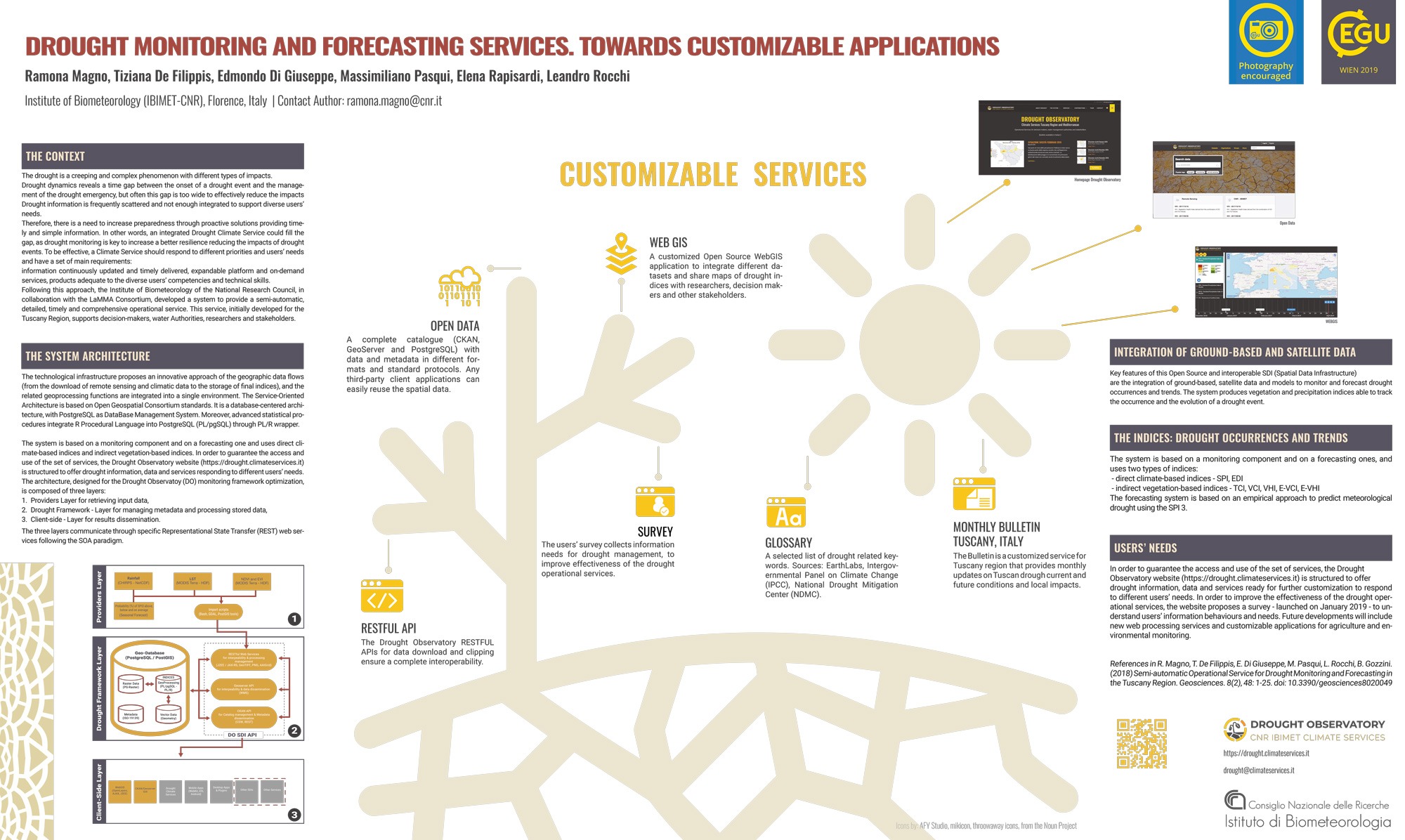EGU General Assembly 2019 (Vienna, 7–12 April 2019)
Poster on “Drought monitoring and forecasting services. Towards customizable applications”
Drought dynamics reveals a time gap between the onset of a drought event and the management of the drought emergency, but often this gap is too wide to effectively reduce the impacts Drought information is frequently scattered and not enough integrated to support diverse users’ needs. Therefore, there is a need to increase preparedness through proactive solutions providing timely and simple information. In other words, an integrated Drought Climate Service could fill the gap, as drought monitoring is key to increase a better resilience reducing the impacts of drought events. To be effective, a Climate Service should respond to different priorities and users’ needs and have a set of main requirements: information continuously updated and timely delivered, expandable platform and on-demand services, products adequate to the diverse users’ competencies and technical skills. Following this approach, the Institute of Biometeorology of the National Research Council, in collaboration with the LaMMA Consortium, developed a system to provide a semi-automatic, detailed, timely and comprehensive operational service. This service, initially developed for the Tuscany Region, supports decision-makers, water authorities, researchers and stakeholders. Key features are the integration of ground-based and satellite data, and the indices to monitor and forecast drought occurrences and trends. The technological infrastructure proposes an innovative approach of the geographic data flows (from the download of remote sensing and climatic data to the storage of final indices), and the related geoprocessing functions are integrated into a single environment. The Service-Oriented Architecture is based on Open Geospatial Consortium standards. It is a database-centered architecture, with PostgreSQL as DataBase Management System. Moreover, advanced statistical procedures integrate R Procedural Language into PostgreSQL (PL/pgSQL) through PL/R wrapper. The system is based on a monitoring component and on a forecasting one, and uses direct climate-based indices and indirect vegetation-based indices. In order to guarantee the access and use of the set of services, the Drought Observatory website (https://droughtcentral.it) is structured to offer drought information, data and services responding to different users’ needs. The Open Data section includes a complete catalogue (CKAN, GeoServer and PostgreSQL) with data and metadata in different formats and standard interoperable services. The WebGIS is a custom Open Source Web Application integrating different datasets and sharing maps of drought indices. The Bulletin is a customized service for Tuscany region that provides monthly updates on Tuscan drought current and future conditions and local impacts. Finally, the glossary: a selected list of drought-related keywords from different sources such as EarthLabs, IPCC, National Drought Mitigation Center. The RESTFUL APIs are also available for data download and clipping to ensure interoperability. In order to respond to users’ needs and improve the effectiveness of the drought operational services, the website proposes a survey – that will be launched by the end of January 2019 – to understand users’ information behaviors and needs. Future developments will include new web processing services and customizable applications for agriculture and environmental monitoring.
Magno R.*, De Filippis T.*, Di Giuseppe E.*, Pasqui M.*, Rapisardi E.*, Rocchi L.*
*IBIMET – CNR (Institute of Biometeorology of the National Research Council).



